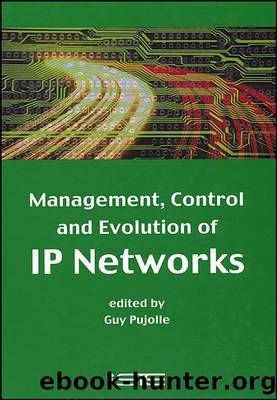Management, Control and Evolution of IP Networks by Guy Pujolle

Author:Guy Pujolle
Language: eng
Format: epub
Publisher: Wiley
Published: 2013-02-21T16:00:00+00:00
16.4.2. Higher level communication protocols
A communication protocol common to all smart cards has been defined: ISO 7816-4. This is an archaic protocol based on message exchange. It only defines reading and writing operations for raw data without defining the high level interface such as data flows or files, which slows the development of applications that use a smart card.
To hide this protocol, several approaches propose an interaction with the card with the help of higher abstraction level protocols.
In [ITO 99], the author proposes accessing the smart card file system transparently by integrating it into UNIX type system file structure in the manner of NFS [SAN 85]. The operating systemâs automatic handling of the complexity of the ISO 7816 communication protocol greatly facilitates the development of applications.
There exist different approaches to access smart cards via the HTTP protocol, whose use is widespread in the World Wide Web (WWW).
[BAR 99] proposes accessing the card by URLs that are relayed by an HTTP proxy. This proxy, working on the computer on which the card is connected, translates the cardâs destination URLs into a series of specific APDUs.
The authors of [REE 00] followed a very different road by implementing an HTTP server directly into a smart card. They implemented a TCP/IP communication specific stack between the card and the computer to which it is connected in order to link the network card.
To open the world of GSM networks to the Internet, the authors of [GUT 00] propose implementing an HTTP server in SIM cards by using the SIM Toolkit14. To function with the current mobile GSM terminals, the authors recommend the GSM operatorâs use of HTTP proxies. These encapsulate the HTTP requests into SMSs15 that they send to the mobile terminal.
Javaâs RMI method is used in [MIC 01] to describe the smart cardâs resources. Two APDUs are successively used to choose and invoke the smart cardâs service. This method is limited to the use in the Java environment.
Download
This site does not store any files on its server. We only index and link to content provided by other sites. Please contact the content providers to delete copyright contents if any and email us, we'll remove relevant links or contents immediately.
| Automotive | Engineering |
| Transportation |
Whiskies Galore by Ian Buxton(41525)
Introduction to Aircraft Design (Cambridge Aerospace Series) by John P. Fielding(32885)
Small Unmanned Fixed-wing Aircraft Design by Andrew J. Keane Andras Sobester James P. Scanlan & András Sóbester & James P. Scanlan(32570)
Craft Beer for the Homebrewer by Michael Agnew(17930)
Turbulence by E. J. Noyes(7696)
The Complete Stick Figure Physics Tutorials by Allen Sarah(7135)
Kaplan MCAT General Chemistry Review by Kaplan(6591)
The Thirst by Nesbo Jo(6432)
Bad Blood by John Carreyrou(6271)
Modelling of Convective Heat and Mass Transfer in Rotating Flows by Igor V. Shevchuk(6219)
Learning SQL by Alan Beaulieu(6031)
Weapons of Math Destruction by Cathy O'Neil(5825)
Man-made Catastrophes and Risk Information Concealment by Dmitry Chernov & Didier Sornette(5644)
Digital Minimalism by Cal Newport;(5388)
Life 3.0: Being Human in the Age of Artificial Intelligence by Tegmark Max(5182)
iGen by Jean M. Twenge(5158)
Secrets of Antigravity Propulsion: Tesla, UFOs, and Classified Aerospace Technology by Ph.D. Paul A. Laviolette(4984)
Design of Trajectory Optimization Approach for Space Maneuver Vehicle Skip Entry Problems by Runqi Chai & Al Savvaris & Antonios Tsourdos & Senchun Chai(4837)
Electronic Devices & Circuits by Jacob Millman & Christos C. Halkias(4743)
